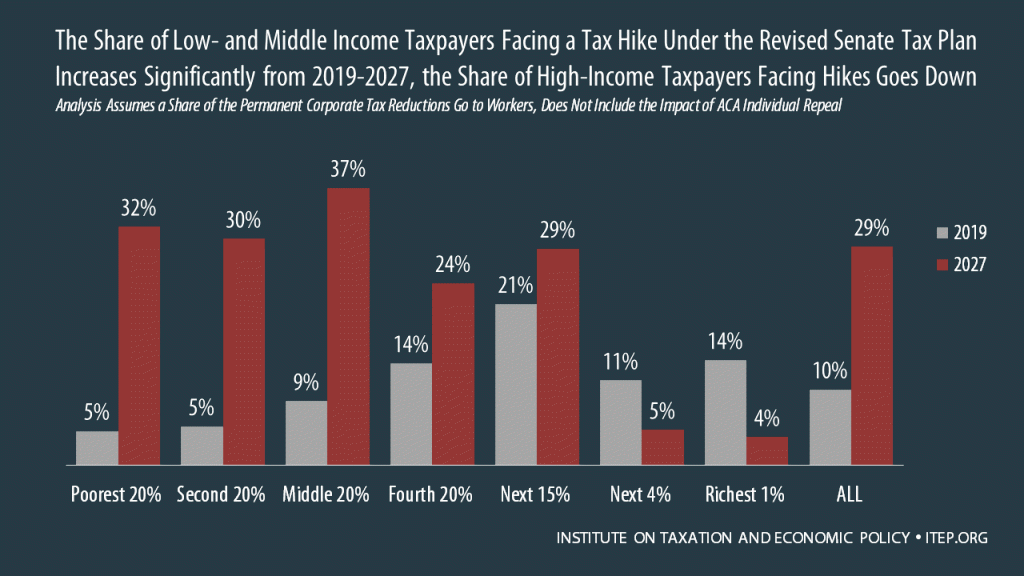Poorest 20 percent would receive the biggest tax hike
A 50-state analysis of the tax plan that passed the Senate Finance Committee finds that the bottom 60 percent of households overall would face a tax hike in the later years of the plan, while the richest 1 percent, corporations, and foreign investors would continue to enjoy significant tax cuts, the Institute on Taxation and Economic Policy said today.
Senate Finance Committee Chairman Orin Hatch took umbrage with the assertion that this plan is by the rich and for the rich. “But what else besides a giveaway to the rich can you call a plan that is careful to maintain tax cuts for corporations and the wealthy, while increasing taxes on the bottom 60 percent of taxpayers and taking away health care from millions of low- and moderate-income households to help pay for it,” said Alan Essig, executive director of ITEP.
Key findings from the analysis of the revised Senate plan (Unless stated otherwise, all the below points look at the last year of the plan, 2027):
- The poorest 20 percent of Americans face an average tax hike that is bigger in total dollars and as a share of income than any other income group.
- The average taxpayer in the bottom 60 percent faces a tax increase.
- The top 1 percent would receive an average tax cut that would dwarf cuts received by any other taxpayers in the top 40 percent. For example, the top 1 percent would receive an average cut of $9,080. Meanwhile the top 5 percent (excluding the top 1 percent) would receive an average cut of $940.
- Foreign investors would receive tax cut benefits that outweigh tax cuts for all U.S. households by nearly three to one.
- Taxpayers in 19 states would pay more in net taxes than they would under current law. These states are diverse both economically and politically.
- In 2019, half the tax cuts would go to the top 5 percent of taxpayers.
- This plan becomes most regressive in its later years. While the average taxpayer would receive a tax cut in the first year of the plan, the effects change dramatically in later years.
- The share of lower-income taxpayers facing a tax hike in 2027, the last year of the plan, would go up, while the share of higher-income people facing a tax hike would go down. For example, in 2019, 5 percent of the poorest 20 percent of taxpayers would face a tax hike, but by 2027, the share would climb to 32 percent. For the middle 20 percent it is 9 percent in 2019 v. 37 percent in 2027. But for the richest 1 percent, it is the opposite: 29 percent of taxpayers in that group face a tax hike in 2019 v. 10 percent in 2027.
ITEP modeled the effects of the plan as it is written. The plan that passed the Senate Finance Committee would let tax cuts for individuals expire after 2025 while maintaining corporate tax cuts. This change explains why wealthy investors and the top 1 percent would still reap immense benefit from the tax cuts.
In addition, the plan proposes to roll back the Affordable Care Act’s individual mandate to finance the plan. This provision is expected to save the government more than $300 million because it would pay subsidies for far fewer low- and moderate-income individuals and families. The Congressional Budget Office estimates up to 13 million people may lose health care as a result.
“The Senate bill has become an Obamacare repeal bill with generous tax cuts for corporations and the wealthy,” Essig said. “It’s unpopular with voters for several reasons: It’s a formula for redistributing wealth to the already wealthy and making income inequality worse. No good can come from this plan unless you are wealthy or a corporation.”



